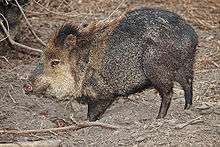Pecari
Pecari is a genus of mammals in the peccary family, Tayassuidae.[1] The genus was monotypic until the description of P. maximus in 2007,[2] but the scientific evidence for its status as a species separate from P. tajacu has later been questioned,[3][4] leading the IUCN to treat it as a synonym.[5]
| Pecari | |
|---|---|
 | |
| Collared peccary | |
| Scientific classification | |
| Kingdom: | Animalia |
| Phylum: | Chordata |
| Class: | Mammalia |
| Order: | Artiodactyla |
| Family: | Tayassuidae |
| Genus: | Pecari Reichenbach, 1835 |
| Species | |
|
Pecari maximus | |
Species
- Pecari maximus Roosmalen et al., 2007 – giant peccary (Brazil) - disputed
- Pecari tajacu Linnaeus, 1758 – collared peccary (Southwestern United States, Mexico, and Central and South America)
gollark: Unrelated, but it turns out that Cookie Clicker's "garden" feature supports surprisingly complex self-sustaining ecosystems.
gollark: ```As companies embrace buzzwords, a shortage of blockchain cryptocurrency connoisseurs opens. Only the finest theoretical code artisans with a background in machine learning (20 years of experience minimum) and artificial general intelligence (5+ years of experience) can shed light on the future of quantum computing as we know it. The rest of us simply can't hope to compete with the influx of Stanford graduates feeding all the big data to their insatiable models, tensor by tensor. "Nobody knows how these models really work, but they do and it's time to embrace them." said Boris Yue, 20, self-appointed "AI Expert" and "Code Samurai". But Yue wasn’t worried about so much potential competition. While the job outlook for those with computer skills is generally good, Yue is in an even more rarified category: he is studying artificial intelligence, working on technology that teaches machines to learn and think in ways that mimic human cognition. You know, just like when you read a list of 50000000 pictures + labels and you learn to categorize them through excruciating trial and error processes that sometimes end up in an electrified prod to the back and sometimes don't. Just like human cognition, and Yue is working on the vanguard of that.```
gollark: *was about to ask that*
gollark: I mean, if they're yours, in most cases having physical access means you can just read off all the data, password or not.
gollark: It was a joke...
References
- Groves, C. P. (2005). Wilson, D. E.; Reeder, D. M. (eds.). Mammal Species of the World: A Taxonomic and Geographic Reference (3rd ed.). Baltimore: Johns Hopkins University Press. ISBN 0-801-88221-4. OCLC 62265494.
- Roosmalen, M.G.M.; Frenz, L.; Hooft, W.F. van; Iongh, H.H. de; Leirs, H. 2007. A New Species of Living Peccary (Mammalia: Tayassuidae) from the Brazilian Amazon. Bonner zoologische Beitrage 55(2): 105–12.
- Gongora, J., Taber, A., Keuroghlian, A., Altrichter, M., Bodmer, R.E., Mayor, P., Moran, C., Damayanti, C.S., González S. (2007). Re-examining the evidence for a ‘new’ peccary species, ‘Pecari maximus’, from the Brazilian Amazon. Newsletter of the Pigs, Peccaries, and Hippos Specialist Group of the IUCN/SSC. 7(2): 19–26.
- Gongora, J., Biondo, C., Cooper, J.D., Taber, A., Keuroghlian, A., Altrichter, M., Ferreira do Nascimento, F., Chong, A.Y., Miyaki, C.Y., Bodmer, R., Mayor, P. and González, S. (2011). Revisiting the species status of Pecari maximus van Roosmalen et al., 2007 (Mammalia) from the Brazilian Amazon. Bonn Zoological Bulletin 60(1): 95–101.
- Gongora, J.; Reyna-Hurtado, R.; Beck, H.; Taber, A.; Altrichter, M. & Keuroghlian, A. (2011). "Pecari tajacu". The IUCN Red List of Threatened Species. IUCN. 2011: e.T41777A10562361. doi:10.2305/IUCN.UK.2011-2.RLTS.T41777A10562361.en. Retrieved 10 January 2018.
This article is issued from Wikipedia. The text is licensed under Creative Commons - Attribution - Sharealike. Additional terms may apply for the media files.